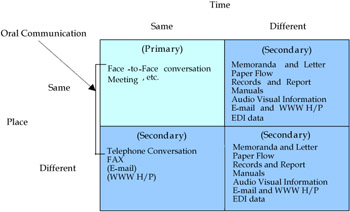Interorganizational Networks and IT
Interorganizational Communications and ITThrough Morimoto's illustration of Barnard's models, how IT is concerned with organization can be shown as Figure 5. Communication plays the most important role in the entire ION. A communication system enables formulation and sharing of the purpose of network and willingness of cooperation between members of a network, and also has a function to harmonize by coordinating various activities among members of the network organization. Furthermore, it furnishes information in order for each member organization to share organizational result and to acknowledge organizational effectiveness and efficiency. As Simon (1976) pointed out, there are two types of communications in an organization: a formal system of communications and an informal network of communications, and to carry out interorganizational activities effectively, efficiently, and smoothly, an informal network of communications has to supplement the formal system of communications. In ION, actual communications are made through boundary personnel in each member organization; in this case, both formal and informal communications are also indispensable. Communication systems are made up of human communication systems and electronic communication systems, and work effectively when both human and electronic communication systems complementarily work together. Simon (1976) listed oral communications, memoranda and letters, paperflow, records and reports, and manuals as media for communication. But I will try to classify them in another viewpoint here. Communications consist of primary face-to-face communications and secondary other communications. I will classify them on the basis of time and place. If we make a matrix of time as the vertical axis and divide it into two same time and different time and place as the horizontal axis and divide it into two same place and different place then we will have four boxes: same time and same place, same time and different place, different time and same place, and different time and different place. And if we plot various procedures of communications in it, then we will have Figure 6.
Primary face-to-face communications (Nohria and Eccles, 1992) are indispensable for effective communications. The problem is how to transfer implicit nuances or even tacit information through secondary communications, though they may be transferable only through face-to-face communications. Against this question, communications using hypertext, in which text, images, movie, and voice or sound, can be combined all-in-one are one answer. But in this case, the point is to what extent hypertext communications can realize the same function as face-to-face communications, and in order to enable them to do so, what kind of technologies are available and what technologies should be combined and utilized. Of course, the best way of communication is:
In addition, communication has both formatted and unformatted communication. In formatted communication, continuous and repeating daily transaction data is transferred. On the other hand, in unformatted communication, information that cannot be formatted is transferred in free format. Anyhow, communication systems play a significant role in ION. However, when communication systems do not work well, the communication systems become constraints of ION. Especially, in ION, the organization culture of the member organization - which determines boundary personnel's way of thinking and doing and intra-organizational network systems become constraints of ION. In order to solve these problems, face-to-face meetings between boundary personnel and standardization of communication protocols, both business and technical, etc., are necessary. Johnston and Lawlence (1988) listed minicomputers and PCs with user-friendly languages, inexpensive general-purpose software packages, data standards and bar codes, information networking capabilities, computer-aided designs, and computer-aided manufacturing as new technological tools for creating a value-adding partnership.
| |||||||||||||||||||||||||||||||||
| | |||||||||||||||||||||||||||||||||
EAN: 2147483647
Pages: 188
- ERP System Acquisition: A Process Model and Results From an Austrian Survey
- Enterprise Application Integration: New Solutions for a Solved Problem or a Challenging Research Field?
- The Effects of an Enterprise Resource Planning System (ERP) Implementation on Job Characteristics – A Study using the Hackman and Oldham Job Characteristics Model
- Distributed Data Warehouse for Geo-spatial Services
- Healthcare Information: From Administrative to Practice Databases

